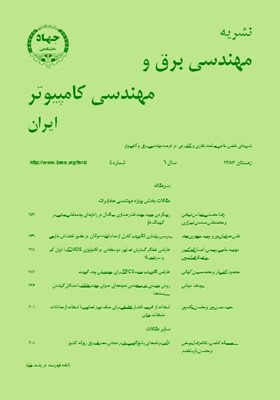استفاده از ضريب انتشار تطبيقي براي حذف نويز تصاوير با استفاده از معادلات مشتقات جزئي
محورهای موضوعی : مهندسی برق و کامپیوترحمید حسن پور 1 , محسن نيکپور 2
1 - دانشگاه صنعتی شاهرود
2 - موسسه آموزش عالی صنعتی مازندران
کلید واژه: ضريب نفوذضريب بازگشتيعادلات مشتقات جزئي,
چکیده مقاله :
در اين مقاله روش جديدي براي حذف نويز تصاوير با استفاده از معادلات مشتقات جزئي ارائه شده است. در بهکارگيري معادلات مشتقات جزئي براي حذف نويز تصاوير از پارامتري بهنام ضريب انتشار استفاده ميشود که انتخاب درست آن تأثير زيادي بر روي حذف نويز و حفظ لبههاي تصوير دارد. در مقالات موجود مقدار ضريب انتشار براي تصاوير مختلف بر اساس سعي و خطا بهدست ميآيند. اما در اين مقاله روشي ارائه ميشود که مقدار اين ضريب بهصورت تطبيقي براي تصاوير در نظر گرفته ميشود. روش ارائهشده در اين مقاله بر روي چندين تصوير استاندارد آزمايش شده است. نتايج اين آزمايشات نشان ميدهند که روش ارائهشده در مقايسه با روشهاي موجود مبتني بر معادلات مشتقات جزئي عملکرد بهتري دارد.
This paper proposes a new approach for image noise reduction using partial diffusion equation (PDE). Diffusion coefficient is an important parameter in PDE for image noise reduction. This parameter affects the noise reduction results and quality of edges in the denoised image. The existing PDE-based image denoising techniques experimentally adjust the diffusion coefficient. This paper proposes a new approach to adaptively adjust the diffusion coefficient. The proposed approach was applied on a number of standard images to evaluate its performance. The results indicate that the proposed approach outperform the existing PDE-based image denoisng techniques.
[1]H. Hassanpour, E. Nadernejad, and H. Miar, "Image restoration using a PDE-based approach," Int. J. of Engineering- Trans. B: Applications, Ar., vol. 20, no. 3, pp. 225-236, Dec. 2007.
[2]E. Nadernejad and H. Hassanpour, "A comparison and analysis of different PDE-based approachesfor image enhancement," in Proc. Int. Conf. on Signal Processing and Communication Systems ICSPCS, Australia, Dec. 2007.
[3]R. C. Gonzalez and R. E. Woods, Digital Image Processing, Prentice Hall, 2004.
[4]J. Weickert, B. M. ter Haar Romeny, and M. Viergever, "Efficient and reliable schemes for nonlinear diffusion filtering," IEEE Trans. on Image Processing, vol. 7, no. 3, pp. 398-410, Mar. 1998.
[5]P. Perona and J. Malik, "Scale-space and edge detection using anisotropic diffusion," in Proc.IEEE Computer Society Workshop on Computer Vision, pp. 16-27, 20 Dec. 1987.
[6]I. Pollak, A. S. Willsky, and H. Krim, "Image segmentation and edge enhancement with stabilized inverse diffusion equations," IEEE Trans. on Image Processing, vol. 9, no. 2, pp. 256-266, Feb. 2000.
[7]P. Perona and J. Malik, "Scale-space and edge detection using anisotropic diffusion," IEEE Trans. on Pattern Analysis and Machine Intel., vol. 12, no. 7, pp. 629-639, Jul. 1990.
[8]S. K. Weeratunga and C. Kamath, "A comparison of PDE-based non-linear anistropic diffusion techniques for image denoising," Image Processing: Algorithms andSystems II, SPIE Electronic Imaging,Santa Clara, US, Jan. 2003.
[9]J. Weickert, B. M. ter Haar Romeny, and M. Viergever, "Efficient and reliable schemes for nonlinear diffusion filtering," IEEE Trans. on Image Processing, vol. 7, no. 3, pp. 398-410, Mar. 1998.
[10]E. Nadernejad and H. hassanpour, "Evaluating diffusion-based image de-noising techniques," inProc. Int. Conf. on Intelligent & Advance Systems ICIAS, pp. 565-570, Kuala Lumpur, Malaysia, 25-28 Nov. 2007.
[11]W. K. Pratt, Digital Image Processing, Wiley, New York, NY, USA, 1978.
[12]Y. Yu and S. Acton, "Speckle reducing anisotropic diffusion," IEEE Trans Image Process, vol. 11, no. 11, pp. 1260-1270, Nov. 2002.
[13]A. G. Weber, The USC-SIPI Image Database, http://sipi.usc.edu/services/database/Database.html, accessed in Nov. 2007.

